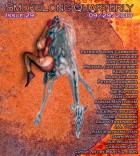As a guest editor, I had the sincere pleasure of reading and selecting your piece “Dancer” for SLQ. They’re even letting me do the interview. Woo-hoo. So here goes.
It begins as “she steps forward, her bare feet cut by the light” and against that “she” is “us”: Let [us] hope there’s not broken glass. The writing handbooks tells us that we cannot identify with unnamed things. This story
is chock-full of them, as if it exists in the world before we named it. What was your thinking in un-naming this world of “Dancer”?
I should say at the outset that “Dancer” is part of a collection of pieces called Domestic Disturbances. All of the pieces in that collection were inspired by or are in conversation with the artwork of the Clayton Brothers. In the ekphrastic tradition, I’m literally translating the narrative thread I pick out of their paintings. I mention this only because I think you’re on to something characteristic of the collection as a whole—these pieces create a world from another created world. They are doubly translated by the imagination and hence, I believe, reach deeper into that part of the unconscious that is beyond mere names and definitions of things. In that kind of a world, inanimate objects appear and disappear at will, characters morph and re-morph, and point of view is never stable. That kind of a world seems much closer to me to my own experience of life where I can’t even remember the person I was yesterday.
This line struck me as full of all kinds of meanings: “We yearn to see him.” The story twirls elsewhere after this line. Yes? No? Maybe so? How do you see this line working in “Dancer”?
Many of the pieces in the collection play with point of view, often switching to an outside perspective, such as that of a bird, or a houseplant, or even a caterpillar, with disturbing regularity. In the case of “Dancer,” I was very conscious about that outside perspective. In this story, it seemed important NOT to name that perspective, NOT to let the reader feel comfortable with the lens through which they’re watching the story—partly because of the narrator’s desperate need to make meaning of the dance he/she/it is watching. That need mirrors the reader’s need. And so to name it would be to distance the reader from his own complicity. But I was also very conscious of the “dance” between the outside observer and the subject of the story—the dancer. For me, there are three dances going on simultaneously in the story—all compelled by different kinds of desire: that of the dancer, the narrator, and the reader.
One of my all-time favorite lines: The night surrounds us like an attic. If this piece were read aloud, I might think I heard “addict.” And I like that aspect of it, too. For me, and of course this might be different for every reader, there’s a weight to that image that makes it stand out among the rest of the lines. I often read that, in very short fiction, every word counts (and of course that’s literally true), but (I’ve got to thinking recently) maybe not every word and image count equally. How does that idea of “every word counting” fit into your own very short fiction and “Dancer,” in particular?
I’m very much of the mind that there is little meaningful difference between flash fiction and prose poetry. They’re both concerned with story at the level of the word. I come to flash fiction after having written two novels and a memoir, and I can say honestly that writing these short pieces was like surviving a near-death experience in that I’ve come out the other side of it a changed man. I can’t tell you how many words I agonized over in those opening paragraphs of “Dancer”—the verb “cut” in the first line, the toe curling inward, the “blue hem.” I could go on and on. Each, at least for me, nails the narrative in ways that would have taken me paragraphs or even pages in a novel. And then “the night surrounds us like an attic” stopped me cold. It was a key moment because it had to say so much about the narrator. I knew I had to set the line on its own; it couldn’t be part of another paragraph. I tried out many, many words until I stumbled upon “attic,” which I can only say felt exactly right. I wasn’t consciously aware of the resonance with “addict,” though I wish I was, as it works so beautifully with the addictions present in the piece.
There is one “they” in the piece: “Thank God. They will dance again.” And I so love that “Oh, how he cares for her!” And I love the exclamation point. What was it like to write this piece, this paragraph? I imagine your fingers on the keyboard like her steps in and out of darkness, your own body twirling in the seat.
I vividly remember writing the first draft version of that paragraph and that it was at that moment that I finally had a sense of what the piece was about. I could feel the narrator’s desperation. The darkness closing in. The willingness of the narrator to delude him/her/itself in order to keep the dance going. I knew the exclamation point was a risk, but it felt right. We’re always told to show the emotion, not to rely on an exclamation point. I’m sure some editors would even reject it out of hand for such a thing. And then the “They will dance again.” The narrator is fully committed with that “they.” We know there’s no turning back. The narrator has now inserted himself into the world of the story, re-imagined it in the way he/she/it needed to, recreated the story in his own image. We can never fully imagine ourselves. It is an ongoing process. And in these pieces, and I would posit in the “real” world as well, we are also constantly re-imagined by those who observe us.
Light/Dark. Her/Him. They/We. Is/Not. A lamp that won’t give light. A final prayer: “Step forward. Dance for Us.” Am I crazy to see something to do with the heavens at work in this piece?
You are not crazy at all. My hope is that the pieces in the collection recreate the world in the same way that Ovid’s Metamorphoses do, or any religious text. Like the narrators in many of the other pieces, the narrator in “Dancer” is actively engaged in re-imagining the world. Identity, in my mind, is a continual act of imagination. It is always in flux. In this particular piece, the almost Biblical imagery of light/dark and her/him has the effect of creating a bare stage, a universe before the Big Bang. The moment is pared down to the act of creation. I think there’s also something of this in Beckett’s hyper-minimalism. He needed to annihilate “reality” as we think we know it in order to re-create it in his image. Any artist, I suppose, must do this.



 The core workshop of SmokeLong Fitness is all in writing, so you can take part from anywhere at anytime. We are excited about creating a supportive, consistent and structured environment for flash writers to work on their craft in a community. We are thrilled and proud to say that our workshop participants have won, placed, or been listed in every major flash competition. Community works.
The core workshop of SmokeLong Fitness is all in writing, so you can take part from anywhere at anytime. We are excited about creating a supportive, consistent and structured environment for flash writers to work on their craft in a community. We are thrilled and proud to say that our workshop participants have won, placed, or been listed in every major flash competition. Community works.